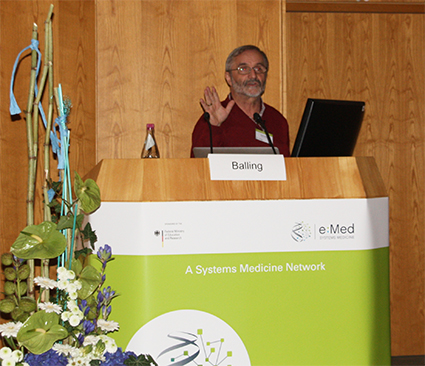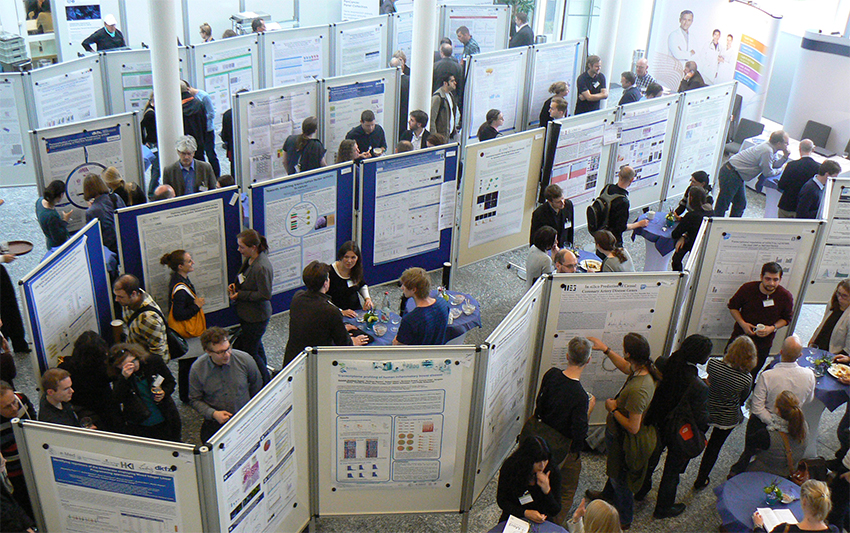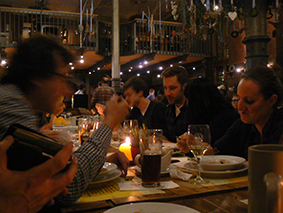e:Med Meeting 2015 - systems medicine researchers met in Heidelberg

From October 26 to 28, more than 260 systems medicine researchers presented the results and conclusions of their committed projects together with the goal of developing new integrative treatment approaches. A total of 44 scientific lectures and 62 poster presentations gave a deep insight into the most current topics of the broad scope of the BMBF support concept e:Med. In five sessions connected to one another that started in each case with an introductory speech, the lectures provided material for high-quality scientific discussions and exchange of ideas. The poster session and the evening social program offered additional opportunities for lively discussions and networking.
Collecting large quantities of data to develop mathematical models with them that describe and predict the complex systemic properties of a whole cell, type of tissue or an entire organ is the principle of systems biology. The transfer of this concept to the e:Med systems medicine approach has a lot of potential for treating illnesses that have hundreds of underlying factors, especially those like cancer, cardiovascular and neuronal conditions as well as inflammation.

"From systems biology to systems medicine – an avalanche is coming" was therefore the title that Rudi Balling, Director of the Luxembourg Center for Systems Biomedicine, also gave to his stimulating evening lecture. He is convinced that "medicine will have to change" and shared his personal advances and thoughts about this could be mastered.
He especially attaches great importance to personal scientific exchange and networking among cooperation partners. He also proclaims the broad and deep "T-shaped researcher".
The integration of genome-wide sequencing data, in particular, plays an important role for transferring laboratory results to clinical applications in interdisci¬plinary e:Med projects. The way this occurs in RNA sequencing was shown by Dirk Hose of the Heidelberg University Medical Center using multiple myeloma as an example. Since this method also identifies rare or changed tumoral RNAs and needs only very little starting material, virtually all patients can be included in the study.
Targeted genomic change – the editing of the genome -– is another cutting-edge subject highlighted simultaneously by four international researchers. The focus is on the discovery of the "Crispr/Cas9" bacterial enzyme and its development to a genetic tool system. "The enzyme has caused a gene editing revolution because it can easily be adapted to modify vertebrate DNA as well," explained Wolfgang Wurst from Munich's Helmholtz Center. Complex animal models can also be created in this way to observe (and even correct) multi component (clinical) mechanisms in the living organism. Hao Yin from the renowned MIT illustrated the potential for therapeutic use by means of examples.
The core subject of systems medicine researchers is to develop computer-aided specific processes for use in clinical applications. Fabian Theis from Munich's Helmholtz Center used a practical example to illustrate this: Many studies are based on patient cohorts and controls. How can the new omics data be brought together with the cohort studies? Theis explained new processes that allow such multivariate data integration using metabolomic data analysis as an example.

Cardiovascular diseases are one of the main causes of death in Europe and for this reason they were the main topic at the annual 2015 e:Med conference. Current studies indicate that many new disease markers do not act via the well-known risk factors. "This means that current therapies do not take advantage of all important disease mechanisms," explained Heribert Schunkert from the German Heart Institute. Five e:Med associations are concentrating their systems medicine analyses to achieve a holistic understanding of cardiovascular diseases.
Johannes Soeding of Göttingen's MPI for Biophysical Chemistry showed how modeling and data integration are used to better detect genetic changes that play a cardiovascular role. Using a dynamic model of the heart after an aortic valve operation, Sarah Nordmeyer of Berlin's German Heart institute showed how the systems medicine approach helps to adjust clinical therapy to the patient.
Cancer was another main topic at the conference. Martin Peifer from the University of Cologne explained how the integration of different data levels has now allowed the identification of key processes in the especially aggressive small-cell lung cancer. In addition, there were lectures about brain tumors as well as liver and pancreatic cancer that described the translation process to a systems medicine analysis of genomic, epigenomic, proteomic and metabolomic data and their computer-aided analysis and modeling. In this way, new insights into the pathological mechanism of different tumoral entities as well as patient sub-groups, new biomarkers and target molecules for medication development are identified.
The four e:Med project groups that deal with subjects of overlapping relevance open to all e:Med members gave brief presentations about their activities and initiatives.
The conference also addressed the ethical implications of systems medicine. Henrike Fleischer and Christoph Schickhardt from IMGB and NCT Mannheim and Heidelberg asked the question: "Do patients have the right to receive their genetic raw data from sequencing studies?" In their ethical analysis about this, they included both the German Genetic Diagnostics Act, scientific freedom and the right to know personal information. They suggested a three-step procedure for reacting to patients and presented it for discussion.

The well-attended get-together after the evening lecture offered the opportunity to discuss the subjects addressed in the lectures in a relaxed setting while sipping wine and eating finger food. The dinner in Heidelberg's old town also led to many good contacts and interesting conversations. In the night watchman's tour that took them to the old town's narrow streets, scientists could learn entertaining facts about the city's history, its streets and squares, and hear the best anecdotes about its personalities.
The social program was made possible by the companies that showed their innovative biotechnological developments and products in a trade exhibit at the conference venue.
The meeting's networking character, in which the "scientific broader view" was in the foreground is seen as one main advantage. It had become clear that the e:Med scientists committed themselves more strongly for creating a systems medicine community.


